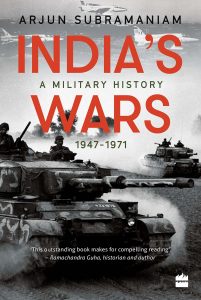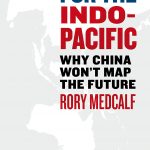
Very little is known by the public about Modern India’s military history, most of the historical discourse is about the freedom struggle and the Non-violent movements of the same. Neither is military history taught in Indian schools. There was no comprehensive account of Modern India’s military history, that is, until AVM Arjun Subramaniam, a retired fighter pilot and a distinguished military historian, who served in the IAF for 36 years, wrote ‘India’s Wars: A Military History 1947-1971’.
Through this book, the author aims to showcase the legacy of the pioneers who shaped the Indian Armed Forces. To do so, he compiles the fragmented military history records and put them into one easily readable and clear joint narrative. He also makes a plea to policymakers to declassify reports, and to learn lessons from both our own and foreign military experiences and implement those lessons. He aims to bring out the historical legacies, ethos and professionalism of the Indian Armed Forces, their contribution in maintaining India’s democracy and how they have coped up with changing times, and have played a central role in nation building.
The book focuses on Indian Military History from 1947- 1971. AVM Subramaniam starts the book by narrating his own experience in the Indian Armed Forces. He also examines the reasons for the absence of India’s military history from India’s historical discourse. The second part of the book presents the history and the evolution of the three branches of the Indian Armed Forces from the Early Modern Era to Independence, chronicling its participation in wars around the world including World War One and World War Two. Instead of attributing the whole of its DNA to the British, the author has also highlighted the influence of Late-medieval Indian military thought.
The third part of the book, aptly titled ‘Teething Years’, covers the three major conflicts fought in the immediate aftermath of India’s independence; The first Indo-Pak war of 1947-1948, the Liberation of Hyderabad and Junagadh, and Operation Vijay, the operation to evict the Portuguese from Goa. The success of the Indian military in beating the Portuguese resulted in a lot of chest thumping, which the author feels deflected pressure from the more pressing situation brewing on the Chinese Border.
Part IV of the book deals with the three major conflicts India fought, all of which took place in diverse terrains. These include the 1962 Sino-Indian war, fought over mountainous terrain, which resulted in a military disaster for India, and finally resulted in much needed reforms regarding the Armed Forces. Still smarting from this defeat, with a poor economy and the nation trying to adjust to the Death of Nehru, Pakistan attacked in the west, over the Plains of Punjab and the swamps of the Rann of Kutch and the deserts of Rajasthan. The situation was dire, and India somehow managed to hold on and bring the battle to a stalemate. In 1971, India was forced to act in support of the Bangladeshi people and the Mukti Bahini and invaded East Pakistan to put down the genocide of the Bangladeshi people. Most of the fighting took place in the marshy and riverine areas of East Pakistan (Bangladesh), where the Indian Army performed spectacularly, conquering Bangladesh in just 2 weeks, and capturing 93,000 Pakistani Soldiers.
He makes interesting observations, noting that the 1971 war is the most well documented of all the wars particularly because India’s strategic and military establishment is comfortable with mostly recording military victories and plans that worked. He instead, emphasizes for the tougher approach to document and study everything, including failures, to understand exactly what went wrong and how to prevent them in the future. He then proceeds to analyze all the conflicts India’s fought through the eyes of Chanakya, ancient India’s foremost strategist.
This book is very well supplied with sources and citations, the author has made sure to back up every statement that has been made in the book with adequate proof. The book also has some extremely rare photographs, and is written in a very simple yet gripping manner, making it feel like reading a narrative, even though it isn’t one. The huge number of secondary readings given here and the easily understandable manner of this book mean that it is ideal for both the regular audience as well as academics who need a starting point to engage in research about this subject. The unique credentials and experience of the author also ensure that this book is able to bring out the organizational aspects of the units themselves, as well as be able to analyze the overall conflict. What makes this book even more unique is the fact that the author wrote this book while still in service, a daunting task surely. In one line, this book is the ultimate starting place for anyone who wishes to know more about Modern India’s Military History. I would also recommend reading ‘Full Spectrum: India’s wars 1972-2020’, the long-awaited sequel to India’s Wars.













